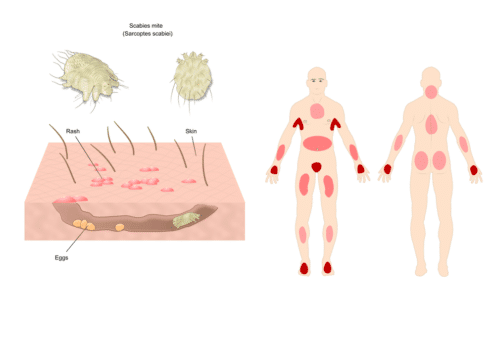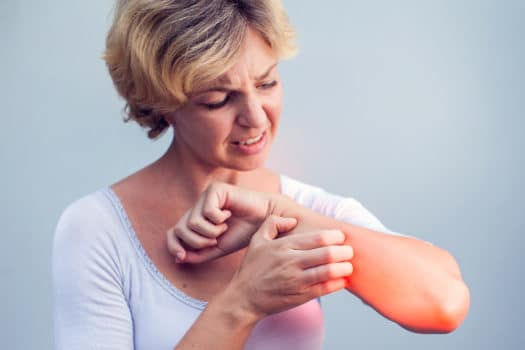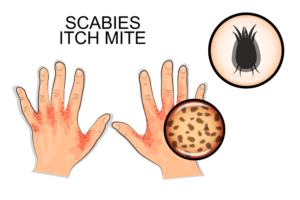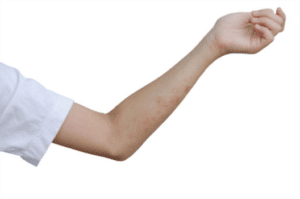What are the symptoms of scabies?
Scabies is an extremely contagious condition that may easily be passed from one person to another through close physical contact. This skin infestation is caused by a mite called Sarcoptes scabiei. This makes an outbreak likely in settings like the family home, childcare group, college, or prison.
The mites live on human skin, then burrow into it and lay eggs.
What does scabies look like on your skin?
If someone gets scabies, the female digs a hole under the skin no more than a few millimeters. Then it lays 10 to 25 eggs inside and dies afterward. This burrowed tunnel is the hallmark of scabies symptoms (These raised lines are usually grayish-white or skin-colored), as well as itching that intensifies at night or when exposed to heat.
Identifying scabies bites and therefore, the distinctive red rash will assist you in finding treatment quickly.
The bumps will seem like hives, knots beneath the skin, patches of scaly skin, tiny bites, or pimples. It could seem like eczema.
Gallery of Scabies Picture:
Click here to see some examples.

Credit: shutterstock.com
What is the first sign of scabies?
It takes one month or more for the skin to react. Despite some scabies symptoms appearing earlier, the most common scabies early signs are:
- Intense itch, particularly at night
- Rash-like pimple
- blisters
- Severe itching causes sores.
How long does it take for scabies to show up after exposure?
Scabies symptoms occur once the skin reacts to the presence of mites and their eggs; If someone never had an infection before, the first time he’s exposed to the scabies mite, it takes up to forty days for symptoms to appear. However, if he had scabies before and gets it once more, this time frame is considerably shorter in subsequent infestations because the body’s immune system is faster to react (the symptoms typically develop more quickly in individuals who’ve had itch before). The symptoms of scabies will begin within two to four days.
Be aware that an infested person will spread scabies to others as soon as he gets it, even before he has symptoms.
How do you know if you have scabies or not?
The symptoms of scabies aren’t always easy to visualize. So, how do you identify scabies? As a result, it may look like something else, such as an allergic rash. The signs don’t appear quickly, as already mentioned, It might appear after six weeks in some cases.
- Itching: mainly at night, itching is the commonest symptom; it can be severe and intense. The itch is usually worse at night when the skin temperature is warmer and can be so intense that it keeps a person awake at night.
- Rash: when the mite burrows into the skin, it forms burrow tracks or lines.
- Sores: Scratching the itchy rash will cause sores. An infection (impetigo) can develop in the sores.
- Thick crusts: crusted scabies or Norwegian scabies, are a severe form of scabies characterized by so many mites that burrow in the skin and exhibit widespread, gray, thick, crumbling crusts. Causing severe skin symptoms.
How do you identify crusted scabies?
Thick crusts that crumble once touched and simultaneously look gray are the foremost common crusted scabies symptoms, additionally known as Norwegian scabies, which is a severe form of infection that develops in people with a weak immune system or elderly…
Can you feel scabies crawling on your skin?
The seven-year itch (Sarcoptes scabiei) is just too tiny; accordingly, it’s troublesome to visualize without using medical equipment. Therefore, feeling scabies on your skin is nearly impossible. You’ll be able to often see the burrow tracks they dig to lay eggs; they’ll appear as tiny raised or discolored lines. This is the most important symptom that lets you know if you’ve got scabies.
Do scabies spread all over the body?
The mites burrow several millimeters long and might develop anywhere on the skin; even so, the mites prefer certain parts of the body to lay eggs. These are places where people usually get scabies rash:
Scabies in adults:
- webbing between fingers
- Around the nails
- Inside Elbows and wrists
- Belt line
- Genital parts (penis and scrotum)
- Nipples
Note: In adults, the mites rarely burrow into the skin on top of the neck.
Scabies in children:
For children, it’s more dangerous, the itch is often widespread and covers the whole body. Infants exhibit symptoms of irritability, sleeping, even more, eating difficulties. Even a child’s palms, head, soles, and scalp may be infested with mites.





